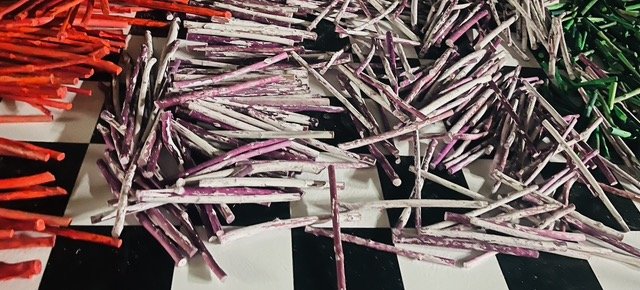Looking for patterns in forested floodplains

The Location:
SAFL’s Model Floor
The Scene:
Brightly painted sticks ranging in size from 0.16m to 0.84m piled in a wheelbarrow, stacked on a black and white checkered table, and jammed at the bends of a model river flowing through a forest of orderly pegs.
A black-gloved woman keeps checking her watch, and dropping sticks into the water at timed intervals. Is this a giant game of Poohsticks?

The Research:
The woman with gloves and stopwatch is undergraduate Jocelyn Prewett, tasked with dropping sticks one at a time into the model floodplain. Nearby, Master’s student Josie Welsh watches her computer monitor: each dropped stick generates new data that she will spend the upcoming weeks analyzing.
The question Josie wants to answer is how wood moves through a floodplain. Where does it accumulate, and what controls the resulting patterns of wood on the floodplain? Josie hopes her findings will be useful to those working on river restoration projects. Adding wood habitat into landscapes is a popular restoration technique, but, like sediment, wood moves within the system. This poses a challenge for restoration experts who want their designs to be effective in the long run. How big does a flood need to get to move the wood, how does it move, and where does it go?
An ecogeomorphologist, Josie loves thinking about how living things - particularly trees - affect the landscape. As this experiment continues, she will be modeling different forest, floodplain, and hydraulic scenarios, like larger floods, more or less dense forest stands, or a narrower or more topographically varied floodplain. She's looking for patterns of movement or accumulation in the variously sized sticks that stand in for logs.
Based in CU-Boulder with advisor Katherine Lininger, Josie has returned to her native Minnesota to utilize SAFL’s unique resources: the large space, specialized equipment, and expert engineers who design and build physical models all the time. SAFL’s capacity for physically modeling is unique, allowing researchers to isolate and explore particular dynamics in complicated natural systems, or to validate mathematical models.
Is it as fun as it looks? “This is just like something I would have done as a child," says Josie, "Except now I have to keep track of a lot of numbers.”

Stay tuned for updates on Josie's experiment!
